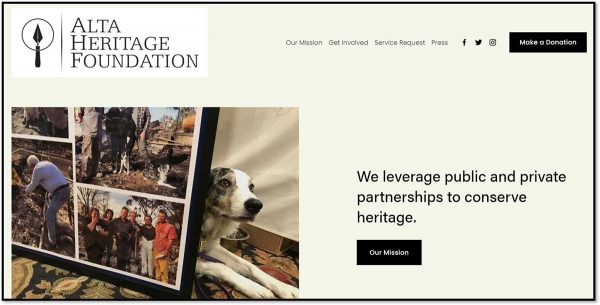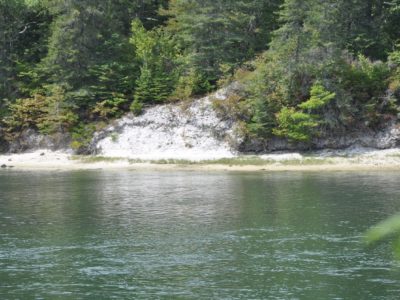
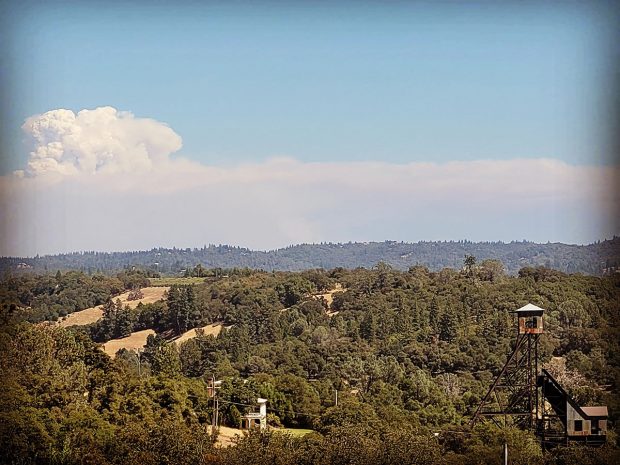
Watching California Burn
Kimberly J. Wooten, Archaeologist, Cultural Studies Office, California Department of Transportation
There’s enough wind outside that it’s rattling the dried leaves on the century old grapevine that wraps up to the second story of my foothill home. My mind makes this instant calculation – wind speeds vs. air temperatures – reaching the conclusion that even though it is windy and extremely dry, it is also too cool to really worry about a fire start. Since 2015, I’ve been living with this new skill set – it’s a disaster skill set, an anxiety response, a calculation of potential danger. My children do this, my friends and family do this. With more than 2,400,000 acres burned in California this fire season already, much of it in northern California, September has been a little piece of hell.
At the beginning of month when I first sat down to write this blog, my 18-year old son was one week into his newly independent life – a freshman enrolled at Lake Tahoe Community College for environmental sciences – when he had to evacuate due to the Caldor Fire. He brought his fishing tackle home, but no clothing. We’d been watching the fire burn up the Highway 50 corridor, moving closer to South Lake Tahoe daily. It would rage through 25,000 acres in a day and, amazingly, another 25,000 at night. The air thickened into a golden brown, mandatory evacuations surrounded the city, and people had to be warned not to evacuate into the lake itself. There is still one part of my mind that will not let me comprehend the possibility that Tahoe, a town of 21,000, can burn; Santa Rosa, Concow, and Paradise tell me otherwise.
For those of you who don’t know the region, the Tahoe Basin is a beautiful, often rugged landscape. Along with Lake Tahoe at an elevation of 6,200 feet, there are dozens of smaller alpine lakes surrounded by granite and pines, sequoias and wildflowers. Cultural heritage traditions extend back in time thousands of years, including Indigenous archaeological sites that are still active summer gathering locations, hidden cabins that date to the early days of car camping, and historic sites like Camp Richardson, Vikingsholm in Emerald Bay State Park, and the late 19th and early 20th century lakeside estates that comprise the Tallac Historic Site. Writing this, I can almost smell the soft fragrance of vanilla that emanates from the Ponderosa Pines in the summer.
The first fire that really impacted my family was the Butte Fire in 2015. My daughter, 15 at the time, and I saw a plume of smoke driving home, wondering if it was over our town. It was massive, even only at a few hundred acres. The next morning, from the windows of our home that overlooked the fire, all you could see was a roiling wall of smoke. Bruised shades of gray, purple, and brown, and this strange golden color that would come to define our summers in California. Ash fell like snow covering everything. Nine of my daughter’s 10 friends had to evacuate. She wandered our home taking photos of everything, convinced we would have to evacuate, that our home would burn. Over the next four days the Butte Fire would explode to nearly 71,000 acres, the third largest fire in California history at the time. Massive, extreme, unstoppable. Six years later, small, typical. The Dixie Fire in northeastern California is over 960,000 acres and is nearly contained, but not until it burned though much of the gold rush community of Greenville.
The Caldor Fire is still actively burning but is progressing much slower. My son returned to his mountain home a week ago, after the narrow band of mountain roadway that is Highway 88 reopened. He passed by the 19th century establishments of Kirkwood Inn, Plasse’s Resort, and Kit Carson Lodge where spot fires persist in nearly inaccessible wilderness. For weeks, my community held its collective breath as the fire threatened these structures. We watched as walls of flames reaching 200 feet high approached, ready to evaporate these histories, our collective memories. But along Highway 88, my son also passed portions of the mountainous route that had been newly thinned, a measure that creates a wider fire break, slowing forward progress and saving natural landscapes, communities, and cultural resources.
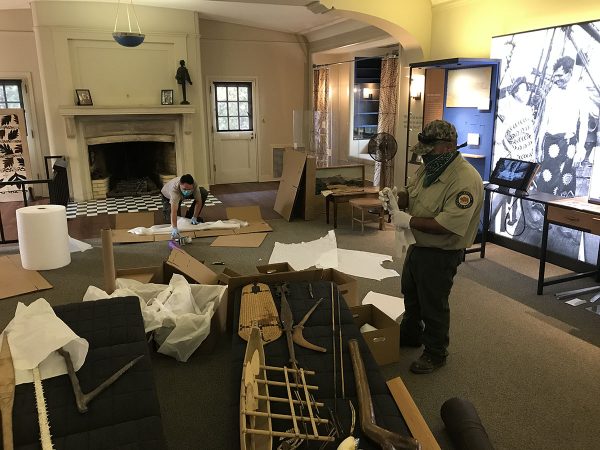
State Parks staff evacuating artifacts from Jack London State Park, Sonoma County, as the Glass Fire approached in 2020. Photo courtesy of Noah Stewart.
As western fires grown in intensity and size and the fire season expands by months, cultural resource specialists are writing fire guidance that is being tested in real time. Historic buildings are wrapped in silvery fire-resistant foils or sprayed with fire-resistant gels. What can be moved from our State Parks and local museums – archaeological collections, the piano that sits in Jack London’s home, precious pieces of our shared cultural heritage – are moved and stored. The economic costs associated with wildfire are enormous. Many agencies and organizations aren’t staffed or funded for protection and prevention measures, the evacuation of museums and facilities, loss of revenue, or the cost of physical recovery for damaged structures and infrastructure that must be repaired or reconstructed. Even when funding is available, cultural resource management companies are finding a shortage of archaeologists to do the work. For agencies and utility companies, after it is safe to enter the burn area, there is the cost of pairing archaeologists with fire recovery crews to ensure archaeological sites are not further damaged by the slow, methodical recovery work.
In terms of the archaeological sites, damage is caused by the heat of the fire itself, but also as trees fall and root balls rip up deposits and features. In the firefighting process, inadvertent damage from the construction of fire breaks or heavy equipment is a necessary cost. Depending on the intensity of the fire, at historical archaeological sites glass artifacts can break, shatter or melt; ceramics can shatter and designs burn away; metal artifacts are weakened, changing their longevity, or burn completely; leather and textiles that remain can be destroyed as fires burn into the soil itself. For dual component sites, the archaeological deposits on the surface are damaged, but their historic structural components, including historic vegetation, are often completely destroyed. With these losses, important relationships between the physical remains and archaeological deposits are also lost. Heritage protected for generations by families and communities compresses into six inches of ash, artifacts to be hauled away by FEMA. Maybe the only plus to a fire is the visibility – what was a tangle of undergrowth is now a barren, blackened landscape, which makes sites pop out visually.
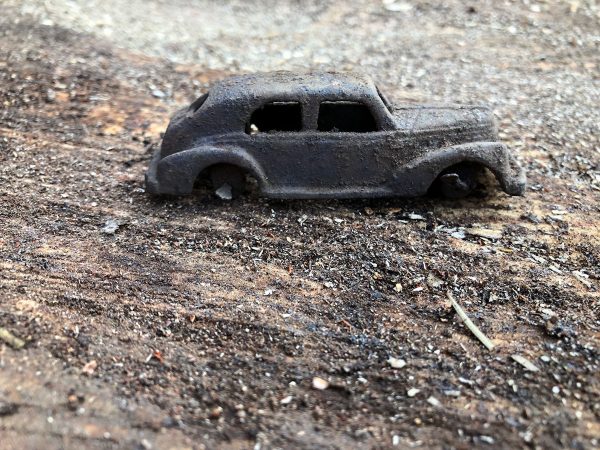
Cast iron 1940s toy car found during monitoring recovery work on the Dixie Fire, Plumas County. Photography courtesy of R. Scott Baxter.
In sitting down to write about the climate crisis and its impacts on our collective cultural heritage – a topic I normally approach from the Contemporary Archaeology perspective of plastic waste – I found myself unable to focus because our collective cultural heritage is burning. In the coming months, my husband will come home from his archaeological fire recovery fieldwork covered in deep, black soot and the distinct smell of recent burns. Summers in the Western United States are filled with a strange, golden light that has to be experienced to understand. It turns your stomach and at the same time it is now almost normal. Because humans are so adaptable, we are adapting ourselves comfortably into climate change. Western nations, for now, can do that.
I know it is cliché, but it’s also the simple truth that in the ashes of wildfires many positive things have taken root. There is a growing acknowledgement of the importance of traditional Indigenous fire technology and management practices and its applicability to the current wildfire landscape. Fire archaeology, a relatively new field, promotes technological advances and will continue to employ archaeologists for the foreseeable future. On a more personal level, in the wake of the 2017 Tubbs Fire which destroyed thousands of homes in the community of Santa Rosa, California, the need to recover human cremains resulted in the formation of the Alta Heritage Foundation (https://altahf.org/). Pairing volunteer archaeologists with cadaver canine teams, the foundation’s mission is to use applied archaeology to support the humanitarian efforts of cremains recovery, as well as address the impacts of climate change on cultural resources. For many of the archaeological volunteers who have worked in the aftermath of wildfires since, helping families recover the cremated remains of loved ones thought lost forever is how we help ourselves cope with the new fire reality of California burning.




